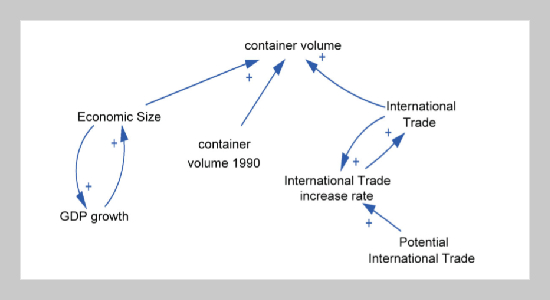REFERENCES
- [1] Cui, Y. H. and Li, W., “Container Throughput Forecasting Based on Combined Model,” China Water Transport, Vol. 7, No. 10, pp. 35�37 (2007).
- [2] Wang, F. L., “Study on the Relationship of Huizhou Port and Huizhou Economy” Journal of Huizhou University, Vol. 29, No. 4, pp. 8�10 (2009).
- [3] Kavoussi, R. M., “Exports Expansion and Economic Growth, Further Empirical Evidence,” Journal of Development Economics, Vol. 14, No. 1, pp. 241�250 (1984). doi: 10.1016/0304-3878(84)90052-X
- [4] Ram, R., “Exports and Economic Growth: Some Additional Evidence,” Economic Development and Cultural Change, Vol. 33, No. 2, pp. 415�425 (1985). doi: 10.1086/451468
- [5] Ram, R., “Exports and Economic Growth in Developing Countries: Evidence from Time-Series and CrossSection Data,” Economic Development and Cultural Change, Vol. 36, No. 1, pp. 51�72 (1987). doi: 10. 1086/451636
- [6] Edwards, S., “Trade Orientation, Distortions and Growth in Developing Countries,” Journal of Development Economics, Vol. 39, No. 1, pp. 31�57 (1992). doi: 10.1016/0304-3878(92)90056-F
- [7] Sheehey, E. J., “Exports and Growth: A Flawed Framework,” The Journal of Development Studies, Vol. 27, No. 1, pp. 111�116 (1990). doi: 10.1080/ 00220389008422186
- [8] Sheehey, E. J., “Exports and Growth: Additional Evidence,” The Journal of Development Studies, Vol. 28, No. 4, pp. 730�734 (1992). doi: 10.1080/00220389 208422255
- [9] Greenaway, D. and Chong, H. N., “Industrialization and Macroeconomic Performance in Developing Countries under Alternative Trade Strategies,” Kyklos, Vol. 41, pp. 419�435 (1988). doi: 10.1111/j.1467-6435.1988.tb01263.x
- [10] Van, H., “The Relationship between International Trade and Economic Growth in Mexico,” North American Journal of Economic & Finance, Vol. 8, No. 1, pp. 1�21 (1997). doi: 10.1016/S1062-9408(97) 90016-4
- [11] Dollar, D., “Outward-Oriented Developing Economies Really Do Grow More Rapidly: Evidence from 95 LDCs, 1976-1985,” Economic Development and Cultural Change, Vol. 40, No. 3, pp. 523�544 (1992). doi: 10.1086/451959
- [12] Tyler, W. G., “Growth and Export Expansion in Developing Countries,” Journal of Development Economics, Vol. 9, pp. 121�130 (1981).
- [13] Feder, G., “On Exports and Economic Growth,” Journal of Development Economics, Vol. 12, pp. 59�73 (1982). doi: 10.1016/0304-3878(81)90007-9
- [14] Moschos, D., “Exports Expansion, Growth and the Level of Economic Development, An Empirical Analysis,” Journal of Development Economics, Vol. 30, No. 1, pp. 93�102 (1989). doi: 10.1016/0304-3878 (89)90052-7
- [15] Salvatore, D. and Thomas, H., “Inward Oriented and Outward Oriented Trade Strategies,” The Journal of Development Studies, Vol. 27, No. 3, pp. 7�25 (1991).
- [16] Chou, C. C., Chu, C. W. and Liang, G. S., “A Modified Regression Model for Forecasting the Volumes of Taiwan’s Import Containers,” Mathematical and Computer Modelling, Vol. 47, pp. 797�807 (2008). doi: 10.1016/j.mcm.2007.05.005
- [17] Park, S. Y., “A Study on the Forecast of Container Volume Using Neural Network,” Journal of Korean Navigation and Port Research, Vol. 26, pp.183�188 (2002). doi: 10.5394/KINPR.2002.26.2.183
- [18] Liu, C. J. and Zhang, Q. N., “Dynamic Prediction of Container Throughput Based on the Time Series BP Neural Network (BPNN),” Port & Waterway Engineering, No. 398, pp. 4�11 (2007).
- [19] Ma, X. C., Wang, X. and Li, H. F., “Throughput Forecast of Port Container Based on Combined Model,” Water Transport Engineering and Transportation, No. 190/192, pp. 74�77 (2009).
- [20] Chen, S. H. and Chen, J. N., “Forecasting Container Throughput at Ports Using Genetic Programming,” Expert Systems with Applications, Vol. 37, pp. 2054� 2058 (2010). doi: 10.1016/j.eswa.2009.06.054
- [21] Peng, W. Y. and Chu, C. W., “A Comparison of Univariate Methods for Forecasting Container Throughput Volumes,” Mathematical and Computer Modelling, Vol. 50, pp. 1045�1057 (2009). doi: 10.1016/ j.mcm.2009.05.027
- [22] Sterman, J. D., Business Dynamics Systems Thinking and Modeling for a Complex World, McGraw-Hill, New York, pp. 86�105 (2000).
- [23] Bass, F. M., “A New Product Growth Model for Consumer Durables,” Management Science, Vol. 15, pp. 215�227 (1969). doi: 10.1287/mnsc.15.5.215
- [24] Kucharavy, D. and Guio, R. D., “Application of SShaped Curves” Procedia Engineering, Vol. 9, pp. 559�572 (2011). doi: 10.1016/j.proeng.2011.03.142
















